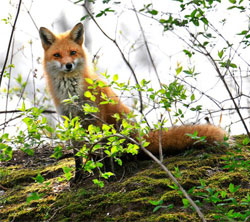Main Content
Article
Red Fox

The red fox (Vulpes vulpes) is likely not native to Indiana. Records suggest that in much of the U.S., red foxes were introduced from Europe and expanded throughout the country. Red foxes likely moved into Indiana with European settlers, possibly in the mid-1800s. They are now a common and charismatic member of Indiana’s wildlife community and are found in a variety of habitats, including in urban areas.
Similar species
General characteristics
- The red fox is red to yellow with a white underside, throat and inner ears. The lower legs and backs of the ears are generally black.
- It has a pointed muzzle, prominent ears and a long, bushy tail tipped in white.
- Other color phases occur, but they are not common. These variations are silver (black fur with white hairs sprinkled among the black), cross (a portion of the fur is grayish or black and a portion of the pelt is red, and the black fur runs across the shoulders and along the back forming a cross when seen from above), and black (all fur is black; this is also known as the melanistic phase).
- The long guard hairs of their pelt cause them to appear larger than they are.
- The average adult weighs 8 to 14 pounds, but can range from 6.5 to 20 lbs.
- Males are usually larger than females.
- Foxes can run up to 30 mph.
Distribution and abundance
Red foxes prefer a mix of habitat such as edges with mixed scrub and woodlands. Old fields, pastures, brush land, farmland and other lightly-forested areas are often preferred. They adapt well to human environments including agricultural lands and urban areas. They occur in all Indiana counties.

Reproduction
Red foxes seldom use dens except for rearing young. The den selected for pup raising may be located in the open or in woods. Dens are generally well-drained and usually have at least two entrances. Foxes may switch dens periodically while pups are young. One litter is born each year in March or April, 51 days after mating. Litters may range from one to 12, but five or six is average.
Newborn foxes are blind until 9 days old and are constantly attended by the female until several weeks old. The male delivers food to his family during this period. The pups first start to leave the den to explore when they are a month old. The young go out on their own in late summer.
Food habits
Red foxes are omnivores. Common foods include:
- Cottontail rabbits
- Ground and tree squirrels
- Mice
- Songbirds
- Berries and fruits
- Vegetables, nuts and vegetation
- Insects and invertebrates
- Carrion or scavenged meat
- Small lambs and poultry may be preyed upon as well
Management and control
Red foxes do not require specialized habitat management due to their adaptability and tolerance of human activity. They are an important component of Indiana's wildlife community due to their effectiveness as predators in controlling small mammals, and they are an important animal in Indiana's fur harvest. Both hunting and trapping are allowed for red foxes. They are protected from hunting and trapping when the young are born and learning to survive. Rules and regulations can be found in the Hunting and Trapping Guide.
Resident landowners and tenants can trap a red fox that is causing damage on their own property without a permit from the DNR. The fox must be euthanized or released within the county of capture on private property on which you have permission to release the fox. In order to prevent the spread of disease, the DNR encourages homeowners to safely and humanely euthanize the foxes, if possible. If you do not want to trap the fox yourself, contact a licensed nuisance wild animal control operator.
Fox prevention and discouragement techniques
- Remove food and water sources to reduce the likelihood of a red fox hanging around your property.
- Never leave pet food outside; take in water dishes at night; take down bird feeders; keep garbage and compost secure from access; clean up fruit from fruit trees or vegetables from gardens.
- Trimming bushes reduces cover for foxes to hide in.
- If you see a fox in your yard, make noise, spray it with a hose, or throw tennis balls or small stones at it to encourage it to leave.
- If you have a fox den on your property, cover the entrances to prevent it from being used again after the young have moved on for the year. Do this in late fall when foxes are no longer using dens.
- Fencing can help prevent foxes from accessing livestock, poultry, pets or gardens. Construct net wire or woven wire fences with openings of 3 inches or less to exclude red foxes from. Bury the bottom of the fence to discourage them from digging under the fence. Combination fences with net and electric wires can also be effective.
- Flashing lights or frightening devices such as radios and timed tape recordings can temporarily scare away foxes.
